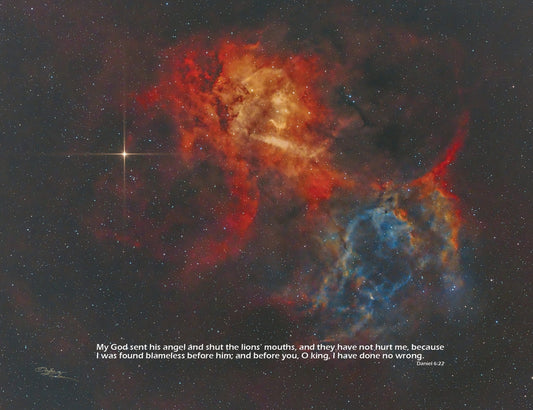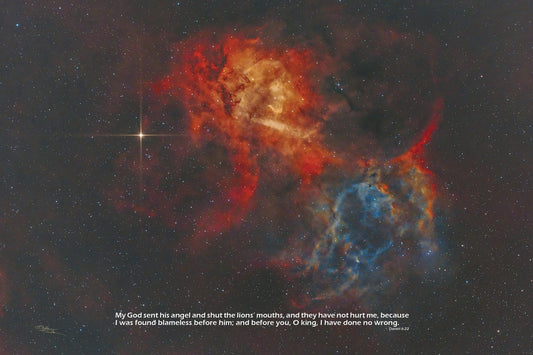Collection: Lion Nebula Saved From The Lion's Den
Daniel 6:22 - My God sent his angel and shut the lions’ mouths, and they have not hurt me, because I was found blameless before him; and before you, O king, I have done no wrong.
The designation SH2 132 refers to a region of interstellar gas and dust in space, often associated with the emission nebula sometimes called the "Lion Nebula." It's important to note that SH2 132 is not as well-known as some other astronomical objects, and it might not be as commonly recognized as more famous nebulae like the Orion Nebula or the Eagle Nebula.
Here is some general information about SH2 132 and the Lion Nebula:
Location: SH2 132 is situated in the constellation Cepheus, which is a northern hemisphere constellation. It's located in the northern Milky Way, not far from the famous Cygnus constellation.
Appearance: The Lion Nebula, within SH2 132, is an emission nebula. Emission nebulae are regions of ionized gas that emit light of various colors due to the presence of hot, young stars within them. They often appear as glowing clouds of gas and are known for their vibrant colors, which are typically produced by hydrogen and other elements.
Stellar Formation: Emission nebulae like the Lion Nebula are often regions where new stars are being born. The intense radiation from young, massive stars within the nebula ionizes the surrounding gas, causing it to emit light.
Notable Features: While the Lion Nebula may not be as famous as some other nebulae, it could have unique features, such as dark dust lanes, star clusters, or other interesting structures within it. Specific details may require observations from telescopes or astrophotography to be fully appreciated.
Observation: To observe the Lion Nebula and SH2 132, amateur astronomers often use telescopes with narrowband filters that isolate the light emitted by hydrogen and other elements in the nebula, bringing out its intricate details.
-
Lion Nebula - SH2-132 - 24"x18" Canvas Print
Vendor:Douglas Trudeau PhotographyRegular price $159.99 USDRegular priceUnit price / per -
Lion Nebula - SH2-132 - 36"x24" Poster Large
Vendor:Douglas Trudeau PhotographyRegular price $54.99 USDRegular priceUnit price / per -
Lion Nebula - SH2-132 - 24"x16" Poster Medium
Vendor:Douglas Trudeau PhotographyRegular price $29.99 USDRegular priceUnit price / per


